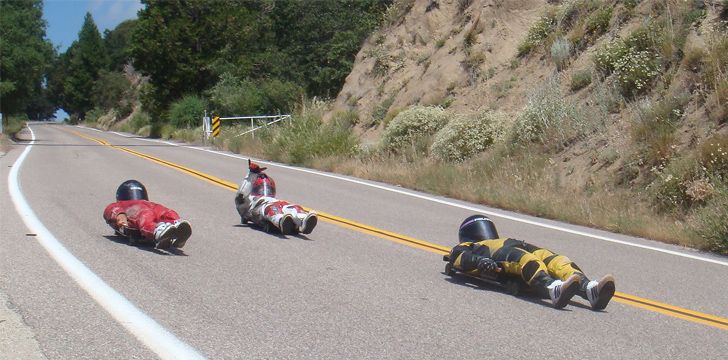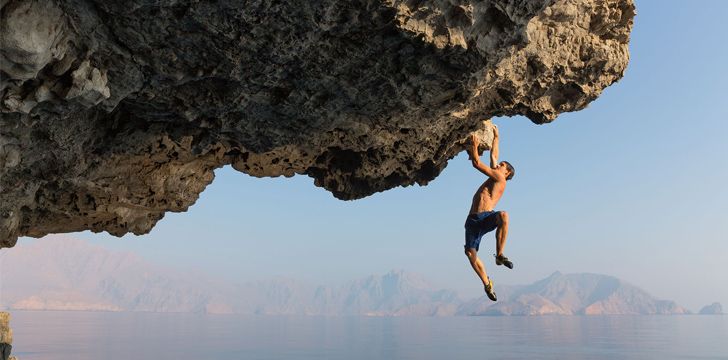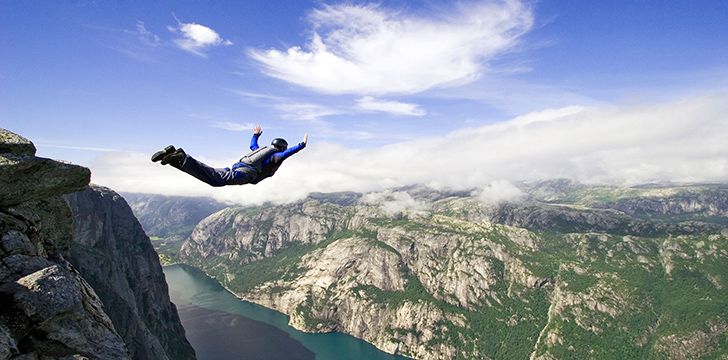Extreme sports tend to draw people in for the adrenaline rush and action.
However, most of them can be done safely – for the most part.
But like anything, there are exceptions.
The more extreme you get, the more dangerous the risky it becomes, and the more thrilling it is to the athletes doing them.
So what are the most dangerous extreme sports?
Here we have some of the top 5 most thrilling, hazardous, and deadly sports around.
Some of them may surprise you!
Big Wave Surfing
With how common surfing is, it’s surprising this sport made it on the list.
However, I’m not talking about your normal surfing.
To count as big wave surfing, the wave should be at least 20 feet tall!
There are so many hazards to this sport that you may not think of.
First off, waves this big are extremely powerful. In a big wipeout, surfers can be pushed 20 to 50 feet (6.2 to 15.5 m) below the surface.
On top of that, it’s easy to get disoriented under the water from a wave that powerful, and it’s imperative that they can regain their equilibrium quickly – and get to the surface before the next wave comes, usually less than 20 seconds later.
The waves are the biggest risk to surfers, due to being held down by the waves.
Surviving one wave is challenging enough, and surviving three is almost unheard of.
Apart from just drowning, there’s also the factor of the ocean floor.
No matter what it is – sand, rocks, or coral, it can all be hazardous to the surfer.
When it comes to big wave surfing, all waves are strong enough to make even a sandy ocean floor feel like concrete.
Rocks are a no-brainer. Getting pummeled into a rock surface will almost definitely injure you.
Finally, the coral will cut you like razors, and even leave broken pieces in your skin that could potentially become infected afterward.
Big Wave Surfing World Record
The tallest wave ever surfed – the 78-foot tall wave in Portugal was surfed by Garrett McNamara in 2011.
Street Luging

Have a need for speed? Then you might want to look into street luging!
But first, there’s a lot to this simple sport that can go wrong.
Street luging was originally developed when skateboarders realized they could lie down on their boards to go faster.
It has since evolved into its own sport, with more refined boards specific to this sport – boards that don’t have breaks.
Because your body is flat when street luging, there is little to no wind resistance, which helps the rider to go faster down the road.
However, because the rider’s body is so close to the ground, it’s easy to hit body parts against the pavement even just by simple steering.
Think about it – even just grazing your elbow against the ground while going 80 miles per hour could potentially skin you to the bone, which in turn could make you crash.
And while riders can get protective gear – suits and helmets – many riders feel like the extra weight only slows them down.
The most common injuries in street luging are bruises, broken bones, or dislocated joints; although there are no dependable statistics yet about deaths.
If you’re not doing this insane sport on a closed road, you have the added hazard of potential vehicles on the road, with collision being difficult to avoid.
The simplicity of street luge could be what draws so many people in – is it enough to peak your interest?
Street Luging World Record
Fastest speed – 101 miles per hour (164 km/h) in Quebec, Canada by Mike McIntyre in 2016.
Cave Diving

While cave diving isn’t an adrenaline-spiking sport, it is definitely among the most deadly.
Consider this – you’re 100 feet deep in the ocean, AND you’re in a cave.
One wrong move and you can’t just swim to the surface; you have to exit the same way you went in.
When cave diving, you deal with getting lost, running out of air, enclosed spaces, getting stranded in darkness, or dealing with issues due to underwater currents.
The margin of error is minuscule, and while the hazards may seem obvious, people still manage to make mistakes all the time.
The precautions cave divers must take are demonstrated in the amount of equipment they need.
Cave divers need almost twice the amount of gear than standard open water divers, such as two tanks, computers, lights, safety lines, and more.
Some divers don’t take the dangers as seriously as they should, which shows in the statistics.
95% of all cave diving deaths were people who weren’t trained properly and went beyond their limits – the rest were pros who knew what they were doing.
On average, about 10 cave divers die per year.
While that may not seem like a high number, to put things into perspective, there are only a few thousand cave divers in the world.
Cave Diving World Record
Deepest Cave Dive – 927 feet (282 m) in South Africa by Nuno Gomes in 1996.
Free Solo Climbing

The popular trend of rock climbing has been on the rise. However, most standard rock climbers use a rope!
That’s where the craziness of free solo climbing comes in.
Free solo climbing is rock climbing alone and without any protective gear.
It all comes down to pure skill, and crossing your fingers (figuratively, of course!).
As one could guess, falling is the most common reason for injuries or death.
But there are a lot of things to factor into the reason for falling.
Even if you’re the best climber, you can’t account for changes in weather conditions, loose holds, or falling rocks.
For the most part, it’s not a matter of if you fall, but when!
So if skill can’t even protect you, what’s the allure?
Many climbers who participate in this risky style say it’s the purest form of climbing – it’s just the climber and the rock.
They say the hassle of gear can get in the way, even if it is safer.
Even so, many free solo climbers admit to the dangers of what they’re doing and discourage others from following in their footsteps – or footholds.
Free Solo Climbing Record
Longest climb – 3,000 feet up El Capitan, Yosemite, done by Alex Honnold in 2017
Base Jumping

If skydiving isn’t intense enough for you, BASE jumping is about as extreme as you can get, and arguably the most dangerous sport in the world.
BASE itself is an acronym for Buildings, Antennas, Spans (bridges), and Earth (cliffs) – AKA, the structures you jump off of.
This insane sport consists of jumping off a fixed structure, as described in the name of the sport, and either parachuting or wingsuit flying to reach the ground.
While you may not be falling as far as you would if you were to skydive, you have significantly less time to deploy your parachute and a nearly invisible margin for error.
BASE jumping has been growing in popularity since 1978, even with its high mortality rate of 1 in 60.
Due to the dangerous nature of this sport, it is illegal in most places of the world, with few exceptions.
In the United States, Perrine Bridge located in Idaho is the only man-made place where BASE jumping is legal year-round without a permit.
Everywhere else, jumpers will likely face arrest.
Due to the legality, many pro-BASE jumpers keep their jumps secretive so as not to be caught by officials.
BASE Jumping World Record
Highest BASE Jump – 25,262 feet (7,700 m) in the Himalayas by Valery Rozov in 2016

















